What would happen minute by minute if a world-destroying asteroid were detected on Earth – after a ‘green’ fireball in space crashed into our planet this week?
NASA’s radar is blaring a signal, alerting scientists that a world-destroying asteroid has been detected that could hit Earth within 10 years.
Governments around the world are quickly alerted to a potentially catastrophic event so they can develop a plan to inform the public.
A year before the impact, space agencies from all countries launch nuclear missiles in the hope of pushing the giant asteroid away from our planet. However, the mission fails.
FEMA orders mass evacuations in the affected area months in advance and the public is told to prepare for the worst as there are only hours left.
NASA has indicated that such a scenario is unlikely to occur in the near future, but this week an asteroid was found hitting Earth just eight hours before impact.
An asteroid hit Earth on Thursday that was detected eight hours before impact, but NASA would have about 10 years to save the world from a world-destroying space rock
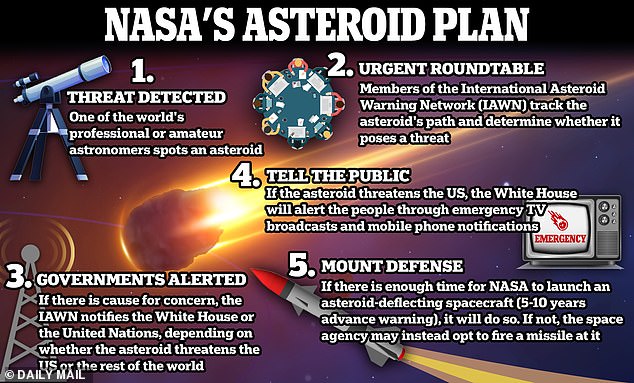
Most asteroids are not on track to hit Earth, but if they were, the sequence of events that would occur after the space rock is discovered is shown above.
The small space rock that flew over the Philippines on Thursday was just 90 centimeters in diameter, not big enough to raise alarms.
A report published by the White House In 2021, it was recommended that a reconnaissance mission would be needed if an asteroid at least 50 meters in size could hit Earth within 50 years.
The document categorized a 1,000-meter-wide asteroid as a “potential global catastrophe,” a five-kilometer-wide space rock as “above the global catastrophe barrier,” and a ten-kilometer-wide object as capable of causing a “mass extinction.”
NASA, FEMA and the United Nations conducted an exercise in April to assess Earth’s preparedness for the discovery of a world-destroying asteroid, which concluded that we need at least 14 years of advance notice.
The discovery of a world-destroying asteroid – 10 years to go
NASA’s ground-based telescopes identify the giant asteroid and compare it to other space rocks in a database to ensure it is a new discovery.
The space agency is running several projects that scan the sky, including the Catalina Sky Survey, which discovered Thursday’s asteroid.
These early warning systems also include NEOWISE (Near-Earth Object Wide-field Infrared Survey Explorer), a spacecraft equipped with a 20-inch infrared telescope with a wide field of view operating in two wavelength ranges.
Once the object is detected, astronomers check the data for brightness and motion to make sure it is not a known object.
The teams then report their findings to the Minor Planet Center (MPC), the only location in the world where asteroids, minor planets and comets are reported.
The MPC and NASA are working together to determine the asteroid’s orbit and thus predict whether its orbit poses a threat to Earth.
The team discovers that the space rock likely entered According to NASA, the satellite will fly five million miles over our planet and send warnings to other agencies around the world.
Now that the world is aware of the impending danger, space agencies from all countries are joining forces to deorbit the asteroid, approximately two years after its detection.
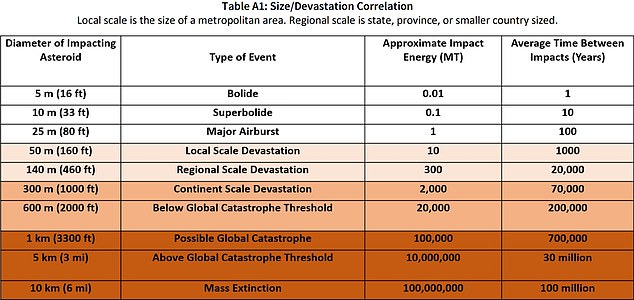
A report published by the White House in 2021 categorized the size of asteroids, estimating that an asteroid at least 3,300 feet wide could be catastrophic
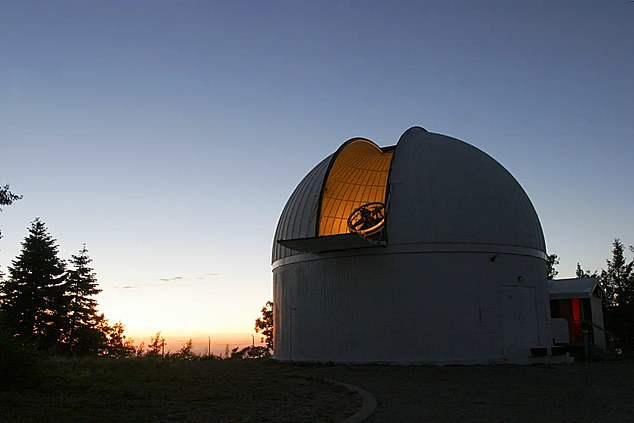
The scenario begins with NASA detecting a world-destroying asteroid 10 years before it hits Earth. The agency has telescopes all over the world, including the Catalina Sky Survey in Arizona that detected Thursday’s asteroid hitting our planet
Launch of an asteroid deflection – two to five years before impact
NASA tested a strategy in 2022 called the Double Asteroid Redirection Test (DART) which the struck an asteroid at a speed of 22,500 kilometers per hour, leaving behind a huge plume of dust and rock and changing the asteroid’s trajectory.
That asteroid posed no threat to our planet, but the space agency could use the strategy to deflect the world-destroying asteroid.
However, in February, NASA’s head of planetary defense warned that a DART-like mission could not get off the ground if the impact occurred within five years.
In the run-up to the launch of humanity’s Hail Mary, NASA and international partners are studying a range of options, including a spacecraft and nuclear weapons.
About five years after the discovery, the group decides to attack the asteroid with nuclear bombs and begins testing a prototype.
Two years before impact, teams send explosives and a detonator to the asteroid.
Kaliat Ramesh, professor of mechanical engineering and materials science at Johns Hopkins University, said VOX: ‘We estimate that it would take an energy of about 200 gigatons of TNT to completely destroy an asteroid with a diameter of 19 kilometers.’
One gigaton is equal to one billion tons of TNT. That means we would need 10 million Hiroshima-sized bombs to destroy the huge asteroid headed for Earth.
The only rockets capable of carrying such a huge payload of nuclear bombs are probably NASA’s Space Launch System (SLS) and Elon Musk’s SpaceX Starship. However, both rockets have proven unsuitable for this type of mission.
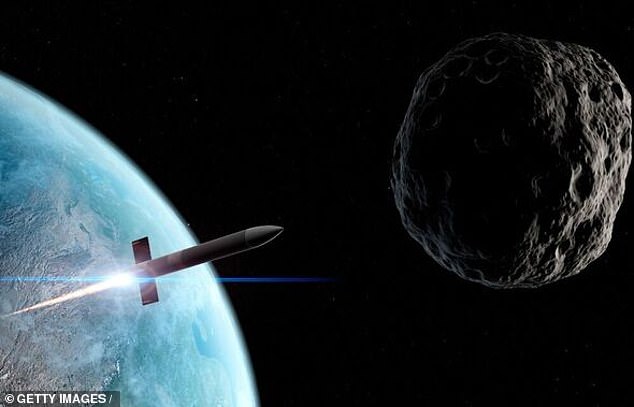
A year before impact, space agencies from all countries launch nuclear deflection missiles in the hope of pushing the huge asteroid away from our planet
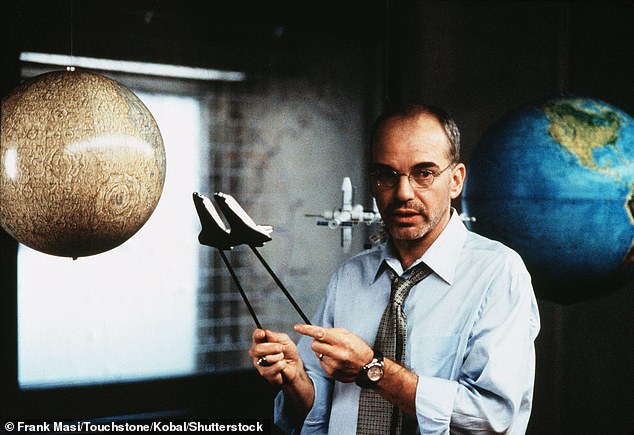
Billy Bob Thornton as Dan Truman, a scientist at NASA, in Armageddon. While it’s a trope of science fiction movies, deflecting asteroids heading for Earth is a real concern
The nuclear option would be faster, a concept familiar to fans of the 1998 film Armageddon, starring Bruce Willis and Ben Affleck.
In the film, NASA sends a group of deep-sea drillers to blow up an asteroid on Earth to save humanity. They have just 18 days to do it.
Evacuation Plan – Months to Hours Before Impact
In the months leading up to the impact, global organizations such as the Planetary Defense Coordination Office (PDCO) would develop detailed impact scenarios, estimating the radius of destruction, atmospheric effects, and potential global consequences.
However, advanced calculations that predict the exact spot where an asteroid would hit Earth would only be available once the asteroid comes within radar range, a new process that could be accelerated using deep space radar.

FEMA would order evacuations around the impact zone to save as many lives as possible

And hours before the asteroid hits, the world will be told to stay indoors and hope for the best.
The information gathered by international agencies is sent to FEMA and other emergency response agencies to warn people in the impact zone. This allows for mass evacuations months before the space rock hits Earth.
Teams would also draw up rescue plans and assemble relief teams that would be deployed almost immediately after the impact to save as many lives as possible.
A NASA report published in 2023 It is estimated that everyone within 300 miles of the impact zone, approximately 150 million people, “would need to evacuate or find or build suitable shelter.”
As the clock ticks down, the public is being instructed to stay home and are being constantly updated and instructed.
After the impact
The asteroid impact would cause widespread devastation, tsunamis that devastate coastal areas and huge shock waves and earthquakes.
Electrical and communications systems around the world fail almost instantly.
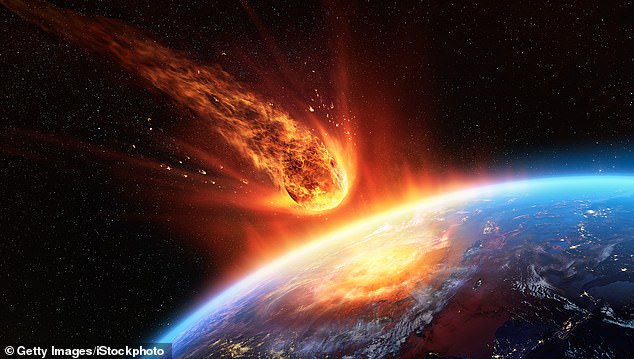
The plan to save Earth would include a diversion strategy, evacuations and shelters at the destination
The sun is blocked by a huge cloud of dust released by the impact, causing a significant drop in temperatures and a ‘nuclear winter’ that can last for decades.
The Earth is said to be in darkness as massive fires rage, depleting oxygen levels.
Billions of people are dead, but those who survived now suffer from hunger, freezing temperatures, and the collapse of civilization’s infrastructure.
